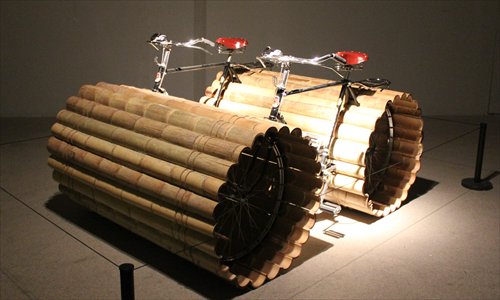Exhibition uses non-German artists to showcase German art scene

Work-Bike by Zhu Jinshi Photo: Xiong Yuqing/GT
When a place becomes a center for art, this not only indicates that the local culture of said place has reached a certain level of maturity, it also shows that it has the ability to attract artists from outside. Like Paris in the 1950s and New York in the 1960s, artists around the world visited and moved to these two cities in a search for inspiration, discussion and recognition.
Art Space Germany, an exhibition currently showing at the Central Academy of Fine Arts Museum until January 5, demonstrates how Germany has grown to become a major center for the arts. Supported by the Goethe-Institut China, it brings works by 15 artists born outside Germany, including two Chinese artists Zhu Jinshi and Qin Yufen, who relocated themselves and their art to the country.
Ursula Zeller, the exhibition's curator, explained that they chose to use the word "space" rather than "country" in the title of the exhibition because they wanted to emphasize the open nature of art circles in Germany and how the nation encourages artists from different cultural backgrounds to come to the country and exchange ideas with local artists and develop their reputations within the nation.
"Over the past 150 years, artists coming from other countries to Germany have offered a lot of inspiration that has pushed the development of art in Germany," said Zeller. "Some people worry that foreign culture might clash against local culture, but I believe that conflict and communication between different cultures can only help our own culture develop into something more distinctive, rather than just repeating tradition."
Beijing is the first stop on the exhibition's tour of China, after which it will head to other cities such as Nanjing, Wuhan, Chengdu, Hangzhou, Chongqing, and Xi'an next year.
Mixing it up
"The contemporary scene has long been more colorful and multi-faceted than national labels indicate. Thus this exhibition reflects a piece of German normality. It does not want to export German art traditions, nor to juxtapose non-Western and Western art, nor to rehabilitate art from outside Europe over and above European art," said Zeller.
She told the Global Times that she selected the exhibited works because they demonstrate the dialogue these artists have with local German culture and how they have incorporated contemporary German art into their work. "All the selected artists chose to live in Germany of their own volition. They are first generation migrants who bring different views, knowledge and stimuli from outside."
She used an art work from Turkish artist Ayse Erkmen as an example. In his piece the artist used metal materials from German cars exported to Turkey to make 16 curved cubes that can be placed on the ground in different configurations and observed from different angles.
Zeller also pointed out that looking at how inter-cultural backgrounds have impacted on individuals is another very interesting part of the exhibition. An audio visual work by Candice Breitz focuses on a pair of Korean twins who grew up in Canada. Videos show the girls wearing the same clothing and using the same gestures as they are interviewed. However, although the girls appear to be exactly the same, they give totally different answers to the same questions. "In the heart of my own production, as an artist, is how we are forged and shaped by the various cultural factors around us," said Breitz.
Some other highlights of the exhibition are the works by famous foreign artists that have had a huge impact on art in Germany. For instance, Antwerp-born Belgian artist Marie-Jo Lafontaine's installations, such as Jeder Engel ist schrecklich (Every angel is terrible, 1991/92) focus on fire, referencing an old traditional ceremony. The fire in her art represents a mysterious and unsteady power that reminds viewers of its dangerous potential.
Sixty-nine-year-old artist Joseph Kosuth is a well-known American artist that formed his own school of conceptual art that has a huge impact around the world. His work at the exhibition, One and Three Pans (1965) - which consists of a frying pan hanging on a wall, a picture of a frying pan next to it and a definition from the dictionary for the word "pan" - demonstrates how his distinctive art form combines objects, symbols and language together.
Home away from home
Without displaying any artwork produced by native German artists, the exhibition is able to give visitors a peak into the art of Germany.
Growing up in Johannesburg, South Africa, Candice Breitz had lived 10 years in New York before she moved to Berlin. "During those 10 years, I was never made to feel that I was a part of the New York art community. I felt even after 10 years that I was treated as a foreign artist, whereas almost immediately when I arrived in Germany, I was described as a Berlin-based artist and I felt embraced by the community. That was a large part of the reason that I stayed in Germany and have continuously considered it as my home," Breitz said.
Qin Yufen, who held her first solo painting exhibition through the support of the Heidelberg art society in Germany, talked with the Global Times about what she feels China can learn from Germany.
"The German Government often promotes excellent exhibitions to the world. We should learn this from them. I've seen many Chinese exhibitions overseas, but most of them were exhibiting traditional culture rather than contemporary art. Now that contemporary art in China is growing very fast, I hope we too can start showing overseas," Qin said.
Newspaper headline: Making space